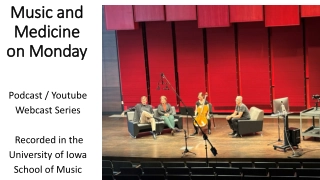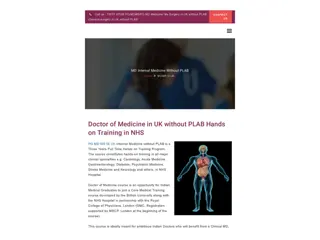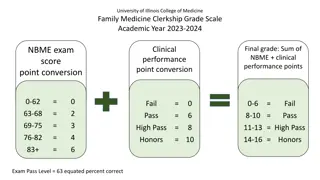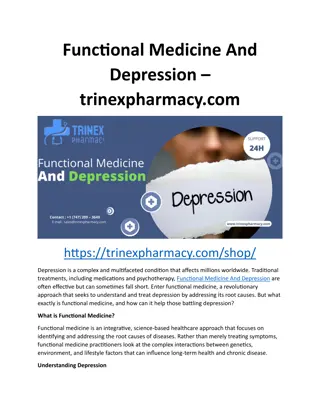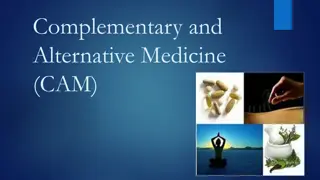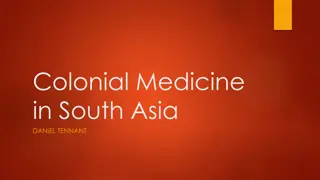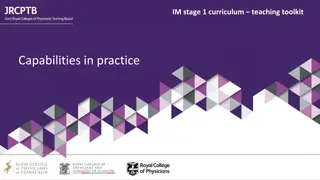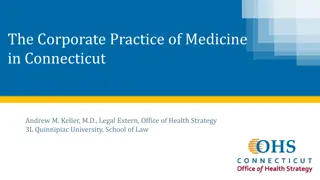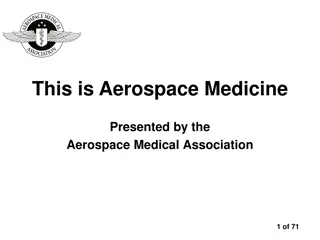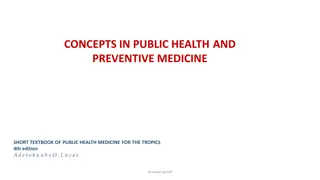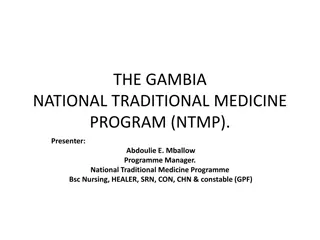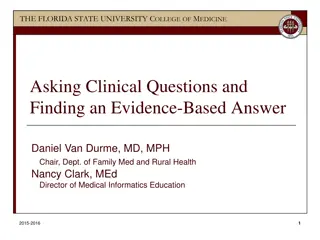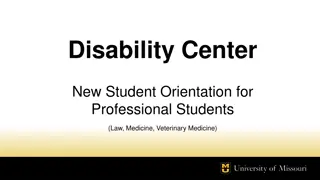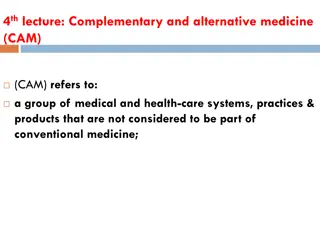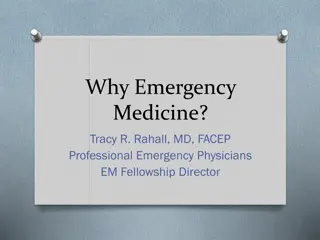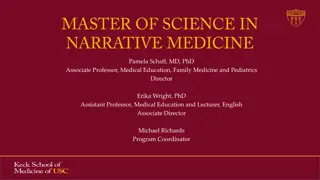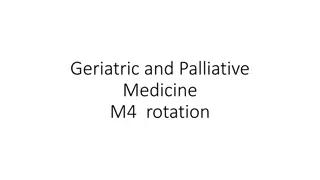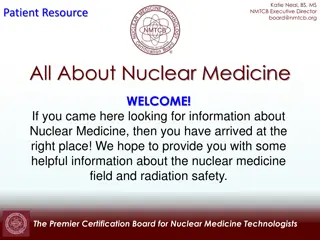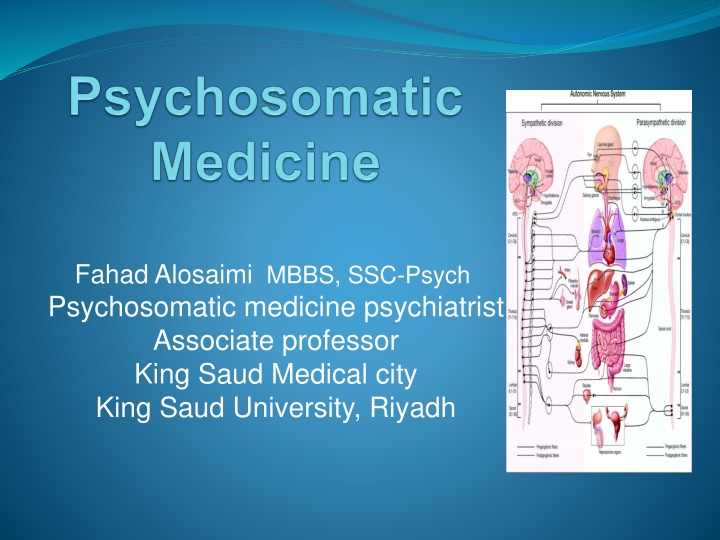
Link Between Stroke and Depression: Insights from Psychiatry
Explore the relationship between stroke and depression, with a focus on post-stroke depression and the impact of antidepressants on recovery and mortality rates. Learn about primary versus secondary psychiatric disorders and how medical factors can influence psychiatric vulnerabilities and outcomes.
Download Presentation

Please find below an Image/Link to download the presentation.
The content on the website is provided AS IS for your information and personal use only. It may not be sold, licensed, or shared on other websites without obtaining consent from the author. If you encounter any issues during the download, it is possible that the publisher has removed the file from their server.
You are allowed to download the files provided on this website for personal or commercial use, subject to the condition that they are used lawfully. All files are the property of their respective owners.
The content on the website is provided AS IS for your information and personal use only. It may not be sold, licensed, or shared on other websites without obtaining consent from the author.
E N D
Presentation Transcript
Fahad Alosaimi MBBS, SSC-Psych Psychosomatic medicine psychiatrist Associate professor King Saud Medical city King Saud University, Riyadh
Case Development 3 Past medical and psychiatric history indicated that the patient has left side CVA 7 years ago. Post stroke, he had 3 months history of low mood, loss of interest, crying spells, excessive guilt feelings and death wishes. Moreover, he had decreased sleep, appetite, energy and concentration. He became isolated and not cooperative during physiotherapy session. After been assessed and managed by psychosomatic psychiatrist, patient s mood and motor function have improved very well.
Stroke After stroke, 25 to 40% of patients meet criteria for Depression. Studies in the 80 s and 90 s demonstrated that post-stroke depression (PSD) was associated with left frontal brain lesions, worse physical and cognitive recovery, and increased mortality. These depressions were shown to be treatable with antidepressants and successful treatment led to both improved recovery and survival. There have now been RCTs showing PSD may be treated and prevented effectively with citalopram, nortriptyline, or reboxetine.
Stroke Later, antidepressants (ADs) shown to improve physical and cognitive recovery over 1 year independent of dep. Over 7 years, antidepressants shown to decrease mortality by 50% even among non-dep pts ...How? Inflammatory proteins are released both by stroke and depression and can have long lasting negative effects on brain function. ADs have been shown to decrease these Inflammatory proteins neurogenesis and synaptogenesis decreased mortality following stroke. However, pts who take both NSAIDs & ADs should be monitored for intracranial hemorrhage. improved recovery and
Primary VS secondary psychiatric disorders Primary Secondary Etiology is: Multi-factorial e.g. schizophrenia Major depressive disorder Etiology : one diagnosable systemic medical disease, CNS disease or substance. e.g. Depression due to SLE Psychosis due to amphetamine In medicine: like Essential hypertension In medicine: like secondary HTN due to renal artery stenosis. Clues suggestive of being secondary: Disturbance of consciousness or vital signs Presence of : non-auditory hallucinations e.g. visual, hard neurological signs physical illness old age onset Clues suggestive of being primary : Normal consciousness & vital signs. Presence of : Auditory hallucinations soft neurological signs Young age onset
Medical factors/illnesses may affect individual vulnerability, course, & outcome of ANY psychiatric disorder. Psychosocial factors/illnesses may affect individual vulnerability, course, & outcome of ANY type of disease. Psychological factors may operate to facilitate, sustain, or modify the course of medical disease , even though their relative weight may vary from illness to illness !.. form one individual to another !.. between 2 different episodes of the same illness in the same individual! .
Illness Vs. Disease Illness: -The response of the individual and his/her family to symptoms -Subjective !, psychosocial, cultural, religious factors Disease: -Defined by physicians and associated with pathophysiological processes and documented lesions -Objective ! Implications !!
Illness Behavior The manner in which individuals monitor their bodies, define and interpret their symptoms, take remedial actions, and utilize the health care system Variety of factors Achievement of objectives Abnormal illness behavior: Inappropriate or maladaptive mode of perceiving, evaluating or acting in relation to one s own health status Illness affirming illness denying
Example of psychosocial factors affecting a medical d (CHD) According to The Interheart study, the population attributable risk factor for MI of Hypertension was 17.9% , while the psychosocial risk factors, were responsible about : a)5% b)10% c)15% d)20% e)>30%
Stress Vs CHD According to The Interheart study, the population attributable risk factor for MI of Hypertension was 17.9% , while the psychosocial risk factors, were responsible about : a)5% b)10% c)15% d)20% e)>30%
INTERHEART Study (EPIDEMIOLOGY, stress & CHD) The Population attributable risk for MI % Percent *Case control study of: n > 29000 in 52 countries. 40 35 30 25 20 15 The Population attributable risk for MI % 10 5 0 *Effect of potentially modifiable risk factors associated with myocardial infarction in 52 countries (the INTERHEART study): case-control study. Yusef S et al. Lancet 2004
Psychosomatic medicine is the subspecialty of psychiatry whose practitioners have particular expertise in the diagnosis and treatment of psychiatric disorders and difficulties in complex medically ill patients (Gitlin et al. 2004) Psychosomatic medicine resides at the interface of physical and mental illness. The clinical practice of psychosomatic medicine is sometimes called consultation-liaison psychiatry (CLP) Since 2001, Psychosomatic medicine has become a subspecialty recognized by the American Board of Medical Specialties
Advantages of psychosomatic medicine (CLP) service 1-Releive symptoms of distress & improve the quality of life of some patient with serious diseases. 2- May improve the course and prognosis of several major medical illnesses 3-Cost-effective : A- Reduce the length of hospital stay. B-Reduce the number of unnecessary investigations (performed for physical symptoms that may actually reflect underlying psychological distress )..
Approach How to do it (effective psych. Consultation) 1-Review patient charts, asking nurses and physician. 2-Obtain good psychiatric history (paying attention to psychological & social factors). 3-MSE & MMSE if cognitive problem is suspected and possibly neuropsychological assessment.
Approach How to do it (effective psych. Consultation) 4-Making logical differential diagnosis among medical , neurological and psychiatric diseases (use multi-axial Dx.) 5-Investigate based on that. 6-Make treatment plan. 7-Follow up plan ( as inpatient & outpatient). 8-Collaborate with both the patient and the referring team.
Clues Suggestive of Organic Mental Disorders(Psychiatric disorder 2ndary to general medical condition) History: Psychological symptoms occurring New onset psychiatric symptoms presenting after age 40. During the course of a major medical illness which had impaired some organ function (e.g., neurological, endocrine, renal, hepatic, cardiac, pulmonary). While taking medications/illicit substance, he had psychoactive effects. Family history of: -ve for primary psychiatric illness.. +ve for medical disease that may present with psychiatric symptoms e.g.: -Degenerative or inheritable neurological disorders (e.g., Alzheimer s disease, Huntington s disease) -Inheritable metabolic disorders (e.g., DM, Pernicious Anemia, Porphyria)
Clues Suggestive of Psychiatric disorder 2ndary to general medical condition Clinical Exam: Abnormal vital signs. Evidence of organ dysfunction, focal neurological deficits. Eye exam: Pupilary changes asymmetries Nystagmus (often a sign of drug intoxication) Presence of altered states of mind, LOC, mental status changes, cognitive impairment; episodic, recurrent, cyclic course Presence of visual, tactile or olfactory hallucinations Signs of: Cortical dysfunction (e.g., dysphagia, apraxia, agnosia) Diffuse subcortical dysfunction (e.g., slowed speech/mentation/movement, ataxia, incoordination, tremor, chorea, asterexis, dysarthria)
Depression & medical illnesses Depression Medical disorder Stress
The global burden of disease, 19902020 Lower Respiratory Infections Diarrheal Diseases Perinatal conditions Depression Heart Diseases Cerebrovascular D/O Heart Diseases Depression Traffic accidents Cerebrovascular D/O COPD Lower Respiratory Infections Lopez et al :Global burden of disease and risk factors, Oxford University Press, New York (2006) 22
Global burden of disease attributable to mental Global burden of disease attributable to mental and substance use disorders: findings from the and substance use disorders: findings from the Global Burden of Disease Global Burden of Disease Study the lancet, 2013) As part of the GBD 2010, epidemiological data was collected for 20 mental and substance abuse disorders in 187 countries. In 2010, mental and substance use disorders accounted for 183 9 million DALYs or 7 4% of all DALYs worldwide. Mental and substance abuse disorders were the leading cause of non-fatal illness worldwide in 2010 (22.8%), The burden of mental and substance use disorders increased by 37 6% between 1990 and 2010. Depressive disorders were responsible for 40% of the burden of illness due to mental and substance abuse disorders. Study 2010 2010 (Whiteford,
Likelihood of Depression Increases with No. of Physical Symptoms at Presentation 70 60 Depression Likelihood /Percentage 50 40 Series1 30 20 10 0 0-1 2 to 3 4 to 5 6 to 8 >9 No. of Physical Symptoms Kroenke K, et al. Arch Fam Med 1994 24
Epidemiology of depression in some medical illnesses % preva lence
Depression as a risk factor for the development of medical illness (CANMAT, ANNALS OF CLINICAL PSYCHIATRY 2012;24(1):82-90) Odds ratio
Depression plus Medically illness Is it serious? Poor outcomes of the medical illness Increased mortality in cardiovascular disease, stroke, diabetes, and ?cancer Chronic medical conditions and depression are interrelated and that treatment of one condition can affect the outcomes for the other. Worse adherence to medical regimens, tobacco smoking, sedentary lifestyle, and overeating. Increased functional disability, decreased self-care. Four to five times greater levels of morbidity, premature mortality, health services use and health care expenditures compared to non- depressed patients with no GMC. *Lin EH. Et al. Gen Hosp Psychiatry. 2006;28:482-486
Pathophysiology : mediating factors between Depression/Stress & medical illnesses Physiological: hyperactivity of the hypothalamic- pituitary- adrenal (HPA) axis. immune activation with release of proinflammatory cytokines. activation of the sympathetic nervous system. Behavioural: Physical inactivity. Smoking. High carbohydrate & high fat diet. Poor adherence to medications. Social isolation.
Dsm-5 criteria for major depression (physical & psychological symptoms) Diagnostic Approach in the Medically Ill: Inclusion approach: count all physical symptoms as part of depression even if possibly explained by the medical illness (to give patients, the benefit of doubt, by treating serious disabling illness like depression).
DIFFERENTIAL DIAGNOSIS 1) Depressive disorder due to another medical condition. 2) Substance-induced depressive disorder, iatrogenic versus other illicit substances. 3) Bipolar I/II disorder, most recent episode depressed. 4) Major depressive disorder(uni polar). 5) Persistent depressive disorder (Dysthymia). 6) Adjustment disorder with depressed mood ( common in medical setting).
Examples of Depression in medically ill patients
EPIDEMIOLOGY (depression & coronary heart disease) Depression has repeatedly been found to predict : early-onset CHD. post-MI mortality (1.5- 5.07 times risk), esp. severe and chronic types. e.g. (HAM-Depression) scale score in first 2 weeks post CHD event predict 7 years mortality risk. increased CHD symptoms(chest pain, fatigue). noncompliance on exercise/medication/smoking . Glassman AH , et al ,Psychiatric characteristics associated with long-term mortality among 361 patients having an acute coronary syndrome and major depression: seven-year follow-up of SADHART participants, Arch Gen Psychiatry, Sep 2009 Keteyian SJ. Cardiovascular symptoms in coronary-artery disease patients are strongly correlated with emotional distress.] Psychosomatics,2008
Prevalence of Diabetes among patients with major psychiatric disorders J Affect Disord. 2002 Jun;70(1):19-26.
Bi-directional Relationship: Independent of multiple confounding factors Type II Diabetes Depression is associated with a 60 65% increased risk to develop Type II Diabetes Depression (Campayo et al. 2010; Mezuk et al. 2008; Musselman et al. 2003)
Type II Diabetes is associated with higher prevalence of depression Depression 2 3 x higher prevalence than in general population Type II Diabetes Mezuk et al. 2008
CANCER Many oncologists consider depression part of the illness and often conclude it therefore does not require treatment. Many also believe that if the cancer can be treated, then the accompanying depression will remit on its own. Many patients deal with the knowledge of having cancer through the expected grieving process. BUT , it may precipitates an episode of major depression in 25%.
Distress along the illness trajectory Time to process Uncertainty Existential Diagnosis End of treatment Palliation Start of treatmentRecurrence Tolerability Body image Loss of hope
Summary (Depression in medically ill) Historically, depression in the medically ill was often considered a natural and expected response to medical illness. Treatment of depression was often considered secondary to treatment of the medical illness, if the depression was even treated at all. Today, this perspective can no longer be accepted. Depression is a systemic disease. The effect of depression on the course of medical illness is multifaceted because there are systemic pathophysiologic implications, as well as psychological and behavioral ramifications.
Summary (Depression in medically ill) The accurate diagnosis and appropriate treatment of depression in the medically ill improves quality of life, enhances the patient's ability to be actively engaged in his or her treatment, decreases symptom quantity and severity, and decreases cost utilization. Most important, it decreases morbidity and mortality.
Four important messages ABOUT MEDS in ESRD Most psychotropic medications are fat soluble, easily pass the blood-brain barrier, are not dialyzable, are metabolized primarily by the liver, and are excreted mainly in bile. The majority of these drugs can be safely used with the ESRD populations. Dosing often involves trial and error. The majority of patients with ESRD both tolerate and require ordinary doses of most psychotropic medications. Toxicity is usually obvious, and we would caution more against undermedicating patients than against overmedication. Cohen LM. Update on psychotropic medication use in renal disease. Psychosomatics. 2004
Summary of psychopharmacology for patients with liver disease To guide pharmacotherapy in liver disease, use Childs-Pughscores with closer monitoring to help to increase safety andtolerability. When choosing psychotropic agents for patients with liver disease, consider the following: Drug interactions e.g : NSAIDs + SSRI for GI bleed Medical Disease E.g : Severity of liver disease, protein binding Age : e.g. : Decreased risk hepatotoxicity in adults Drug profile E.g.: Hepatotoxicity, hyperammonemia Hepatic modifications E.g: Bupropion vs. citalopram Sanjeev Sockalingam, psychopharmacology updates, 2009
Case Development 4 Elaborating more in his past history, His wife reported that when she was pregnant with her last child 27 years ago, she has needed to get help of psychiatry -because of sadness, crying, anxiety and disturbed sleeping. Also, after delivery, she became behaviorally disturbed plus hearing voices asking her to kill her child.
Analyze the symptoms (presented and expected) in this case and signs, including mood, thoughts, cognition, perception and physical aspects Discuss other elements related to the case includes possible etiological reasons Discuss the initial possible diagnosis of this case and different types of such clinical presentation Discuss about Perinatal psychiatry
CONSEQUENCES OF DEPRESSION IN PREGNANCY Mother Baby Suicide unhealthy practices e.g. smoking Poor nutrition Less compliant with prenatal care Increased pain ,nausea, stomach pain, SOB, GI symptoms..etc low birth weight, smaller head circumferences, premature delivery, etc poor mother-infant attachment, delayed cognitive and linguistic skills, impaired emotional development, and behavioral issues emotional instability and conduct disorders, attempt suicide, and require mental health services
Depression in pregnant Women 10% to 16% of pregnant women fulfill the diagnostic criteria for MDD, and even more women experience subsyndromal depressive symptoms Many of depressive symptoms overlap with the physical and mental changes experienced during pregnancy
Treatment of Depression in pregnant Women Antidepressants reduce risk for preterm birth and cesarean delivery compared with Depressed women untreated BUT has more neonatal complications, including low Apgar score (? Withdrawal syndrome) (Heli Malm, AJP, 2015). Sertraline, Escitalopram and Citalopram are the Safest SSRIs in Pregnancy (Reefhuis J et al, BMJ 2015) SSRIs : exposure show NO consistent information to support specific morphological teratogenic risks. NO association between TCA use in pregnancy and structural malformations. Presumed associations between antidepressants and malformations may be complicated by poly-drug interactions

